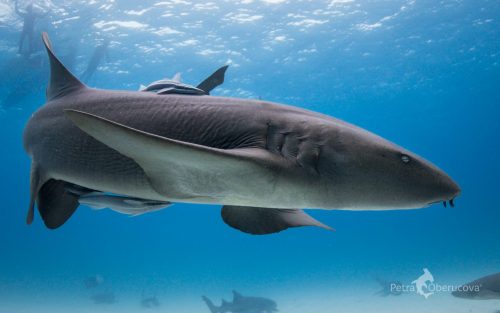A Jaw-some Experience
In the past few days, the Tropical Ospreys have been diving and snorkeling the seas tagging, feeding, and observing nurse sharks. Obviously this isn't the only thing we did, however, this blog will be focused on the amazing (jawsome) nurse shark. The nurse shark, or Ginglymostoma cirratum, is a bottom dwelling shark with a yellowish-tan to dark brown color. As an adult, these sharks can reach anywhere from 7.5-8 feet in length and over 200 pounds. For the past few days, we've been swimming with juveniles and adult nurse sharks (maybe some "teenagers" too). Although mostly nocturnal, today our team was able to draw these sharks out using a bait bucket. Their preferred foods are mollusks, crustaceans and stingrays, but will happily eat a fish corpse as a snack. During the day, nurse sharks tend to stay underneath reefs, in caves, or in a crevice and rest. Nurse sharks are not aggressive towards humans, but (just like Captain Slate said) if your fingers are there, they'll go for them. Sadly, nurse shark attacks have actually increased over the years due to ecotourism. A fun fact about these sharks is that their name "nurse" was actually derived from the word "Nusse", which is applied to cat-sharks in the family Scyliorhindae. However, nurse sharks actually are not a part of this family, but the name has since stuck. In Caribbean waters, this shark is called a "tiburon gato, which translates to cat-shark. Historically, nurse sharks have been over-hunted for their liver oil and skin. Their skin, although rough to the touch, actually produces high quality leather that is sought after. In modern times, nurse sharks are still being hunted for their fins, meat and skin. Sometimes, when there is no reason to do so, fishermen will catch and kill nurse sharks because they are seen as a nuisance. Other times, they are caught in traps and either brought up and released, brought up and killed because they are "pests", or they die in the traps themselves. In commercial fisheries, many companies try their best to release nurse sharks alive when they're caught in their lines or nets. Currently, these sharks are on the IUCN red list because they are not endangered, but their presence in Florida has gradually decreased over the years.

 |
| Tropical Ospreys aboard the boat (with a small child that was rather annoying, but cute I guess) |
To learn more about nurse sharks, click here: https://www.floridamuseum.ufl.edu/discover-fish/species-profiles/ginglymostoma-cirratum/
To learn more about Captain Slate's, click here: https://www.captainslate.com/
Nurse Sharks seem to be a very common species in the wild and especially in aquariums. With how wide spread they are I was surprised we didn't catch more in the shark tagging you were talking about. Getting to see them while snorkeling during the shark feeding was incredible though.
ReplyDeleteNurse sharks definitely became my favorite shark species during this trip. I had no idea people saw them as a nuisance. It’s so sad that there numbers are declining because they are such incredible animals. Seeing them almost face to face during the shark feeding was absolutely amazing and one my favorite parts of this trip!
ReplyDelete